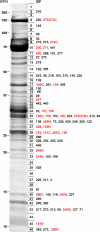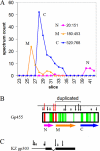Proteome of the large Pseudomonas myovirus 201 phi 2-1: delineation of proteolytically processed virion proteins
- PMID: 20233846
- PMCID: PMC2871425
- DOI: 10.1074/mcp.M900488-MCP200
Proteome of the large Pseudomonas myovirus 201 phi 2-1: delineation of proteolytically processed virion proteins
Abstract
Pseudomonas chlororaphis phage 201 phi 2-1 produces a large structurally complex virion, including the products of 89 phage genes. Many of these proteins are modified by proteolysis during virion maturation. To delineate the proteolytic maturation process, 46 slices from an SDS-polyacrylamide gel were subjected to tryptic digestion and then HPLC-electrospray ionization-tandem mass spectrometry analysis. The scale of the experiment allowed high sequence coverage and detection of mass spectra assigned to peptides with one end produced by trypsin and the other end derived from a maturation cleavage (semitryptic peptides). Nineteen cleavage sites were detected in this way. From these sites, a cleavage motif was defined and used to predict the remaining cleavages required to explain the gel mobility of the processed polypeptide species. Profiling the gel with spectrum counts for specific polypeptide regions was found to be helpful in deducing the patterns of proteolysis. A total of 29 cleaved polypeptides derived from 19 gene products were thus detected in the mature 201 phi 2-1 virion. When combined with bioinformatics analyses, these results revealed the presence of head protein-encoding gene modules. Most of the propeptides that were removed from the virion after processing were acidic, whereas the mature domain remaining in the virion was nearly charge-neutral. For four of these processed virion proteins, the portions remaining in the mature virion were mutually homologous. Spectrum counts were found to overestimate the relative quantity of minor polypeptide species in the virion. The resulting sensitivity for minor species made it possible to observe a small amount of general proteolysis that also affected the virions.
Figures






Similar articles
-
Pox proteomics: mass spectrometry analysis and identification of Vaccinia virion proteins.Virol J. 2006 Mar 1;3:10. doi: 10.1186/1743-422X-3-10. Virol J. 2006. PMID: 16509968 Free PMC article.
-
Digestion pattern of reovirus outer capsid protein sigma3 determined by mass spectrometry.Virology. 2003 Jul 5;311(2):289-304. doi: 10.1016/s0042-6822(03)00154-5. Virology. 2003. PMID: 12842619 Free PMC article.
-
Genome and proteome analysis of 7-7-1, a flagellotropic phage infecting Agrobacterium sp H13-3.Virol J. 2012 May 31;9:102. doi: 10.1186/1743-422X-9-102. Virol J. 2012. PMID: 22650361 Free PMC article.
-
Bacteriophages and viruses as a support for organic synthesis and combinatorial chemistry.ACS Chem Biol. 2012 Jan 20;7(1):123-38. doi: 10.1021/cb200342h. Epub 2011 Oct 31. ACS Chem Biol. 2012. PMID: 21988453 Review.
-
Retrovirus maturation-an extraordinary structural transformation.Curr Opin Virol. 2016 Jun;18:27-35. doi: 10.1016/j.coviro.2016.02.008. Epub 2016 Mar 22. Curr Opin Virol. 2016. PMID: 27010119 Review.
Cited by
-
A Cut above the Rest: Characterization of the Assembly of a Large Viral Icosahedral Capsid.Viruses. 2020 Jul 5;12(7):725. doi: 10.3390/v12070725. Viruses. 2020. PMID: 32635654 Free PMC article.
-
Intracellular Organization by Jumbo Bacteriophages.J Bacteriol. 2020 Dec 18;203(2):e00362-20. doi: 10.1128/JB.00362-20. Print 2020 Dec 18. J Bacteriol. 2020. PMID: 32868402 Free PMC article. Review.
-
Characterization and Genomic Analysis of a Novel Jumbo Bacteriophage vB_StaM_SA1 Infecting Staphylococcus aureus With Two Lysins.Front Microbiol. 2022 Apr 28;13:856473. doi: 10.3389/fmicb.2022.856473. eCollection 2022. Front Microbiol. 2022. PMID: 35572667 Free PMC article.
-
A non-canonical multisubunit RNA polymerase encoded by the AR9 phage recognizes the template strand of its uracil-containing promoters.Nucleic Acids Res. 2017 Jun 2;45(10):5958-5967. doi: 10.1093/nar/gkx264. Nucleic Acids Res. 2017. PMID: 28402520 Free PMC article.
-
Quantitative proteomics reveals metabolic and pathogenic properties of Chlamydia trachomatis developmental forms.Mol Microbiol. 2011 Dec;82(5):1185-203. doi: 10.1111/j.1365-2958.2011.07877.x. Epub 2011 Nov 7. Mol Microbiol. 2011. PMID: 22014092 Free PMC article.
References
-
- Skurnik M., Strauch E. (2006) Phage therapy: facts and fiction. Int. J. Med. Microbiol 296, 5–14 - PubMed
-
- Hanlon G. W. (2007) Bacteriophages: an appraisal of their role in the treatment of bacterial infections. Int. J. Antimicrob. Agents 30, 118–128 - PubMed
-
- Wilhelm S. W., Suttle C. A. (1999) Viruses and nutrient cycles in the sea—viruses play critical roles in the structure and function of aquatic food webs. Bioscience 49, 781–788
-
- Kimura M., Jia Z. J., Nakayama N., Asakawa S. (2008) Ecology of viruses in soils: past, present and future perspectives. Soil Sci. Plant Nutr 54, 1–32
Publication types
MeSH terms
Substances
Grants and funding
LinkOut - more resources
Full Text Sources

